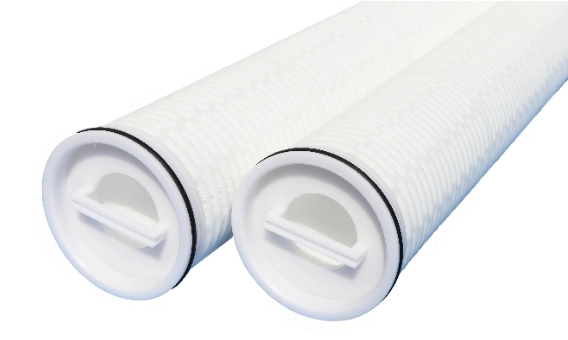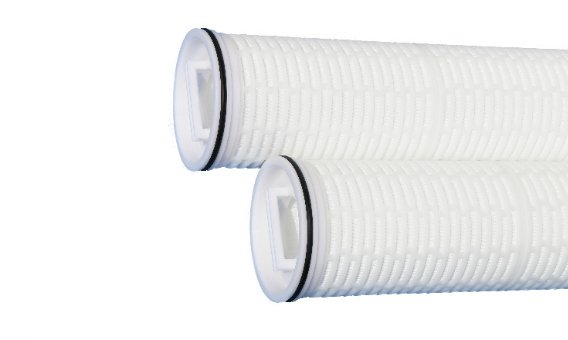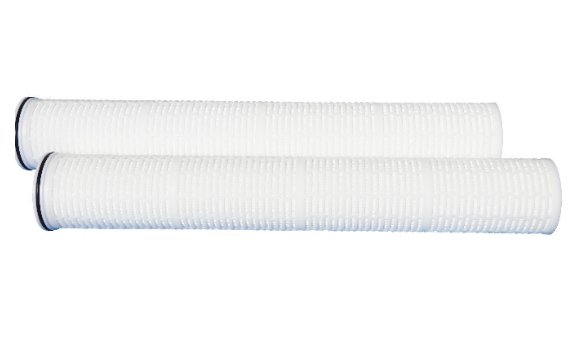High Flow Filter Cartridge
Filson high flow filter cartridge is available in absolute ratings from 1 to 100 microns at 99.98% efficiency.
Among these high flow filters, 1 micron water filter cartridge and 5 micron filter cartridge are more popular.
You can also import Filson high flow filter cartridges by customized size and micron ratings.
High Flow Filter Cartridge
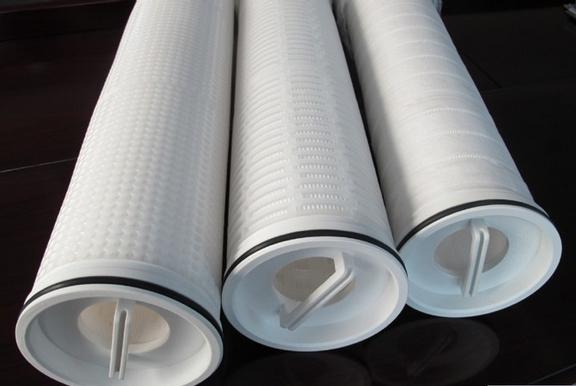
Filson high flow filter cartridges also called high flow water filter cartridge is a kind of water filter cartridge with high quality glass fiber or polypropylene filter media. It has high particle removal efficiency and broad chemical compatibility than a standard micron filter cartridge.
Filson high flow filter cartridge features inside-to-outside flow to keep unwanted particulate trapped within filter. External netting adds extra support and built-in handle makes water filter cartridge change out fast, easy and safe. Thermal bonding of high flow sediment filters guarantees the integrity and eliminates glues or adhesives additives.
- More Details
- Technical Data
- Application
- FAQ Guide
Filson High Flow Filter Cartridges
Filson high flow filter cartridge reduces the overall cost of filtration by saving the number of water filter cartridges and minimizing the frequency of change-outs to lower downtime.
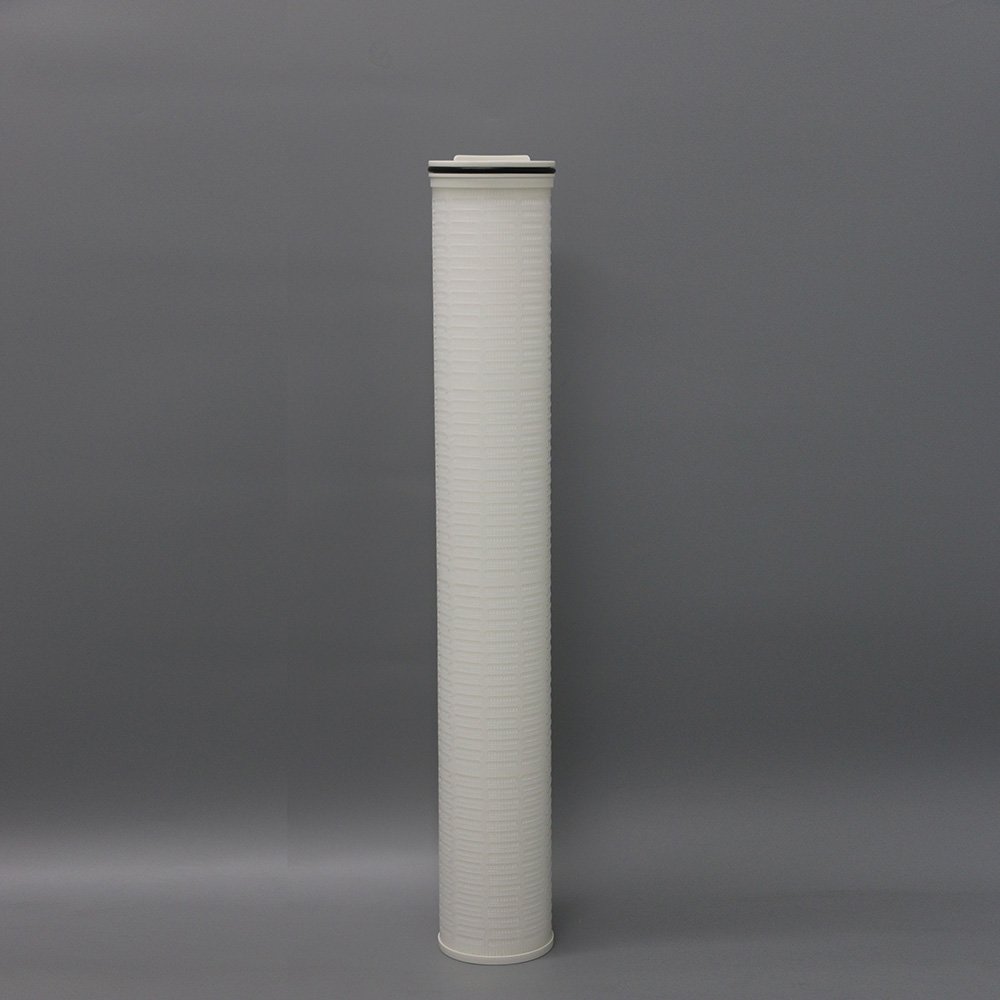
A single 60” length high flow filter cartridge can handle up to 500gpm flow.
Also, Filson high flow water filter cartridges offers low-pressure loss, high dirt capacity, and long on stream life.
Compared to other high flow filter suppliers, Filson high flow filter cartridges are cost competitive and fitted in a wide range of horizontal & vertical cartridge filter housing with the various end fitting chooses.
We can offer high flow water filter replacement including Parker high flow filters, 3M high flow sediment filters, Pall high flow filter cartridges or Pentair high flow carbon water filters…
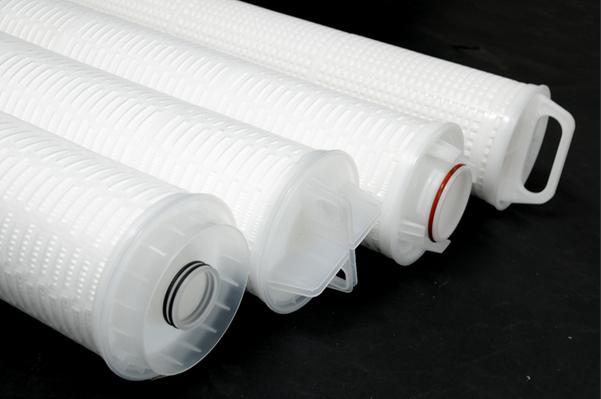
With the Filson’s rich experience in water fitration industry, we can help you remain competitive by being your OEM partner for the high flow filter cartridge.
Whether for water applications, petrochemicals or gas, Filson high flow filter cartridge is an ideal choice for all market applications.
Features of High Flow Filter Cartridges
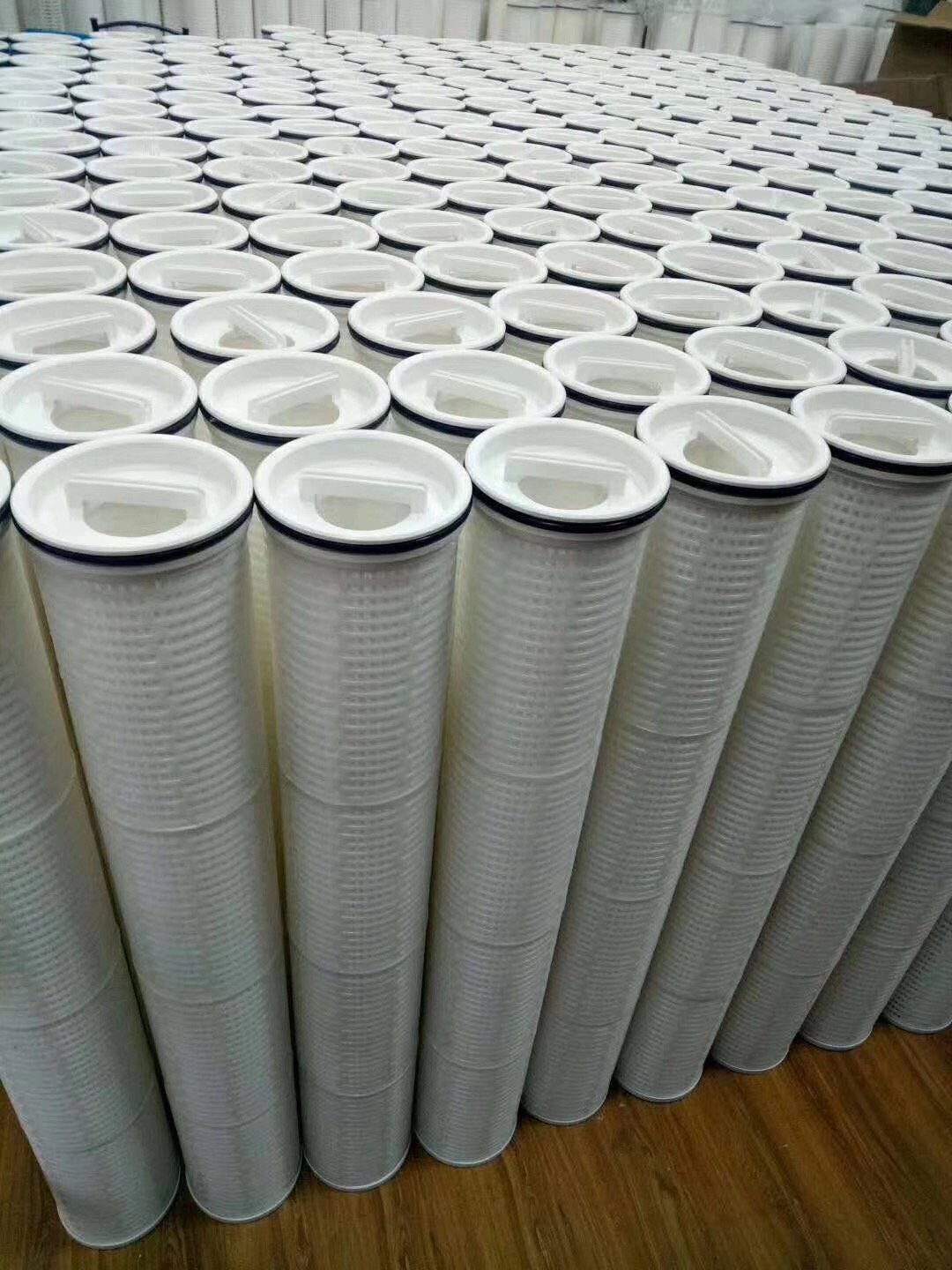
- High contaminant holding capacity for long life
- All materials of construction are FDA listed
- Fewer cartridges for fewer change-outs, thus less labor and disposal cost
- Thermally bonded ensure structure integrity and no additives
- Heavy wall core offers superior strength
- Integrated handle makes change out fast, easy and safe
- Inside-to-outside flow traps particulate within filter
- External netting for additional support
- Compatible with most brand standard high flow filter housings.
Technical Data of Filson High Flow Filter Cartridges
Material of Construction:
- Media: Pleated glass fiber, Polypropylene
- Support layer: Polypropylene
- End adaptor: Glass fiber reinforced Polypropylene
- Seal Material :Silicone, EDPM, Buna, Viton
Dimensions:
- Outside diameter: 6″ (152mm)
- Length: 20 inch(528mm)/ 40 inch(1022mm)/ 60 inch(1538mm)/ 80 inch…
Micron ratings: 1, 3, 4.5, 6, 10, 20, 30, 40, 70, 90, 100 μm
Flow Rate: 175gpm for 20”, 350gpm for 40”, 500gpm for 60” element
Maximum Temperature:
- Pleated glass fiber:121°C
- Pleated PP: 82°C
- Melt Blown PP: 65°C
Change out Differential Pressure: 2.4bar at 20°C
Applications of Filson High Flow Filter Cartridges
- Prefiltration of RO water
- Seawater desalination
- Bottled water, edible oil, soft drinks
- API, solvents, and water filtration in Biopharm market
- Paints and coatings, petrochemical, refineries
- Microelectronics
High Flow Filters: The Ultimate FAQ Guide
This guide will answer all questions you have about high flow filters.
Whether you’re looking for information on high flow filter efficiency, features, advantages, replacement or cleaning process – everything is in this guide.
Take a look:
- What is a High Flow Filter?
- How can you Construct a High Flow Cartridge Filter?
- What are the Features of a High Flow Filter?
- What are the Disadvantages of High Flow Filters?
- Where can you Use High Flow Cartridge Filters?
- What is the Best Filter Media for High Flow Filters?
- Can you Reuse a High Flow Filter?
- How Much can High Flow Filter Cost?
- When should you Replace a High Flow Filter Cartridge?
- What is the Dirt Holding Capacity of a High Flow Cartridge Filter?
- How can you Determine the Service Life of a High Flow Filter?
- How do you Choose High Flow Cartridge Filter Housing?
- What are the High Flow Filter Quality Standards?
- What should you consider when buying high flow filters?
- What Fluid Compatibility Conditions for High Flow Filters?
- Can you clean a high flow cartridge filter?
- What is the Absolute Rating for High Flow Filter Cartridge?
- What is a Micron Rating in a High Flow Filter Cartridge?
- How can you Determine the Particle Removal Efficiency of High Flow Filter Cartridge?
What is a High Flow Filter?
A high flow filter is a special filter designed to optimize performance and filtration efficiency.
High flow filters allow for higher flow rates per filter.
Besides, they have higher chemical compatibility and particle removal efficiency compared to standard filters.
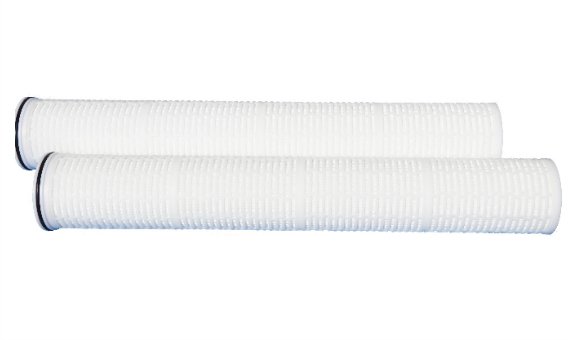
High flow filters
How can you Construct a High Flow Cartridge Filter?
The process involves:
· Purchasing Quality Raw Materials
Ensure that the materials meet the requirement of the quality standards regulatory body in your country.
The materials include fabrics, End caps, O-rings, PP nets, and membranes.
· Pleating the Membrane
Position the materials in a pleating machine appropriately in the desired order from top to bottom.
First, place the PP net, followed by fabrics, membranes, fabrics, and PP net is that order.
Switch on the pleating matching the cut the materials in desired sizes.
· Seam Welding
Perform seam welding using the ultrasonic welding machine on the pleated membranes to form a hollow cylinder
You will use them later in endcap thermal welding.
· Thermal Welding
Use a thermal welding machine to bind the pleated membranes from seam welding in cages.
You can use standard, thick, or stainless steel outer cages.
· Packaging
Pack the filter together with the O-rings in a plastic bag placed inside an inner box.
Pile the small boxes containing single cartridges into a bigger box and keep and secure storage.
What are the Features of a High Flow Filter?
A high flow filter possesses the following features:
- Very high dirt holding capacity
- Superior strength supported by dense wall core
- Joints are thermally bound to enhance structural integrity.
- No structural additives
- Reduced cartridge replacement intervals
- Additional support through the inclusion of external netting
- Filtration process from inside-out flow or outside to inside
- Fast, easy, and safe filter replacement
- Highly compatible with numerous brands of the standard high flow filter housing.
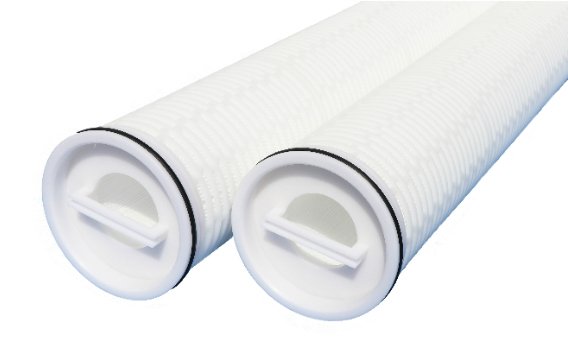
Cartridge filter
High flow filters have several advantages over standard filter cartridges in the long run though they might cost you more money when purchasing.
The following are some of the benefits of using a high flow filter.
· Higher Flow Rate and Better Performance
The filters allow for the passage of a higher amount of the process fluid through the screen, which translates to better performance.
· Effective Filtration
A high flow filter can achieve finer filtration in multiple applications across many disciplines.
Fine furnishing and coating of construction materials used for housing allow them to meet diverse requirements for filtration.
· Less Space
High flow filters can save space and the number of cartridges per square foot. A single cartridge can perform the task of several individual cartridges.
Consequently, it saves up floor space in the factory floor with a considerable reduction in support equipment in the filtration process.
· Economical
The filters have lower downtime costs because the rate of filter replacement is also low as they have a higher dirt-holding capacity than a standard screen.
· High Compatibility
High flow cartridge filters comprise of quality polypropylene, which supports filtration of fluids with various chemical properties.
The broad chemical compatibility allows for the filtration of a wide range of chemically diverse compounds without any additional filtration cost.
· Operation Flexibility
Housings for high flow filters are constructed for multi-purpose functions and easily allows flexibility and modification in manufacturing.
You can swiftly change the type of filtration depending on seasonal demands.
· Environmentally Friendly
You will generate less waste by using high flow filters compared to standard filters.
The filters have reduced change over compared to standard filters and can also be cleaned and reused.
· Technology in Production
You can design high flow filters can using 3D modeling, which enables quick and efficient reproduction of the filters.
This type of printing also makes customizing a filter for customers with specific needs easy hence reducing the overall cost of the filter.
What are the Disadvantages of High Flow Filters?
Though not typical, some users have raised concerns about high-performance filters.
They include;
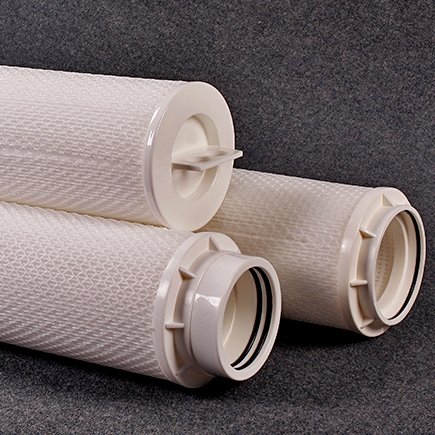
High flow filter cartridge
· Higher Initial Purchase Cost
Most high flow filters are priced higher than standard filters, which can discourage users who have never experienced their benefits from buying one.
· Risk of Exposure to Contaminants
There have been concerns that a high-performance filter is likely to expose the system to higher levels of contaminants because of the high flow rates.
As a result, more internal wear and tear will occur in the interior elements.
Where can you Use High Flow Cartridge Filters?
You can use high flow filter cartridge in many industries to perform diverse filtration tasks under different process applications.
Some of the applications which can use high flow filters include:
- Water production
- (Bio) diesel
- Water pre-filtration in for reverse osmosis
- Geothermal
- Recycling wastewater
- Flushing pipelines
- Production of glycols, gels, and amines
- Process water filtration
- Produced/utility water filtration
- Gravel pack fluids
- Coolants
- Nozzle protection
- Aqueous salt solutions etc
What is the Best Filter Media for High Flow Filters?
Polypropylene microfiber provides the best material for the construction of a high flow filter.
The medium has a broad range of chemical compatibility and can achieve very high particle removal efficiency.
You should manufacture the support layer using polypropylene.
Also, you should not include additives, binders, and silicone in the manufacture of high flow filters for food products.
Can you Reuse a High Flow Filter?
Yes, you can clean and reuse a high flow filter that is cleanable.
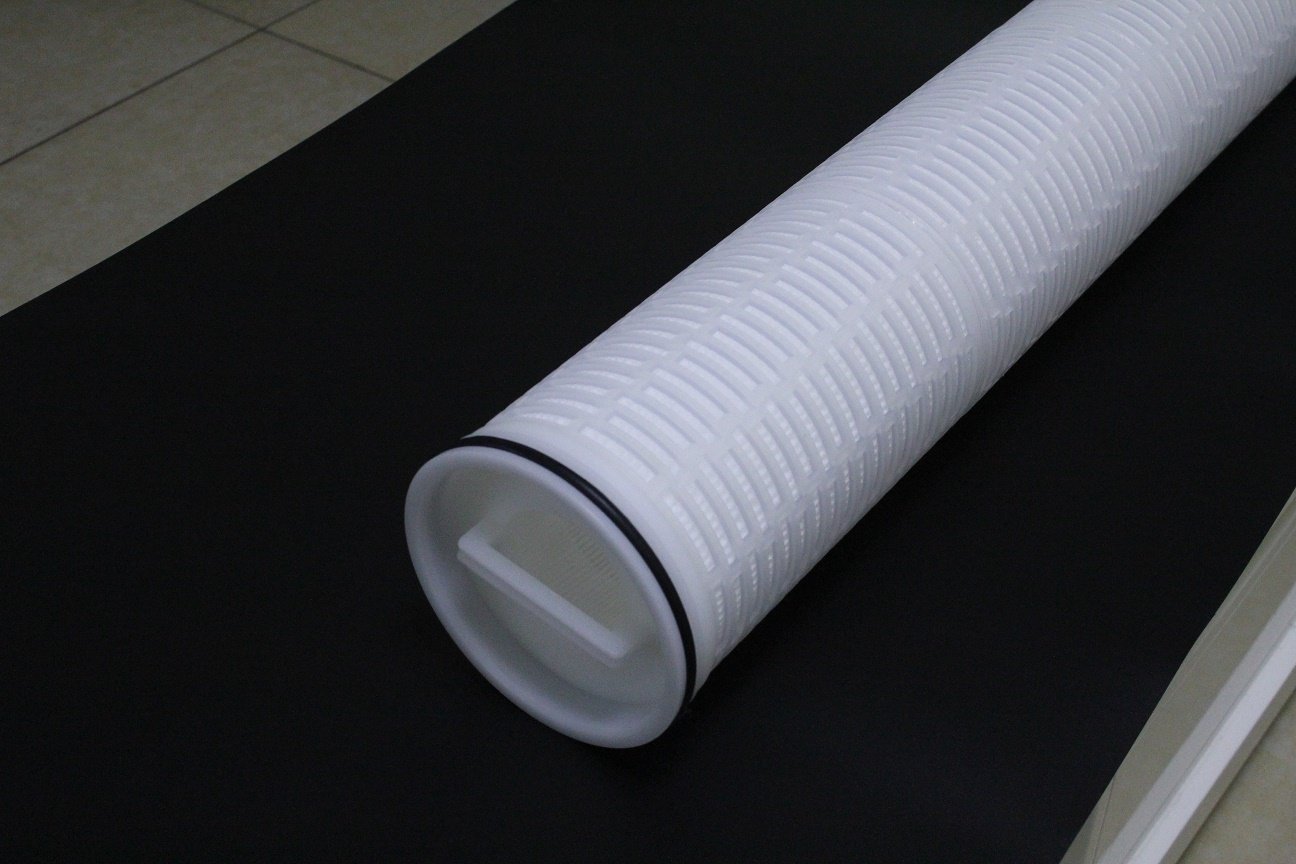
High flow filter element
How Much can High Flow Filter Cost?
The cost varies significantly to size, application, and construction material.
A simple high flow filter cartridge for filtering water can cost between $1.5 to $5.
On the other hand, a multi-cartridge high flow filter can cost up to $6000 apiece.
When should you Replace a High Flow Filter Cartridge?
You should replace the filter cartridges when the differential pressure is about 35 psi (2.4 bar).
However, ensure that you confirm with the OEMs instructions on the recommended pressure drop.
What is the Dirt Holding Capacity of a High Flow Cartridge Filter?
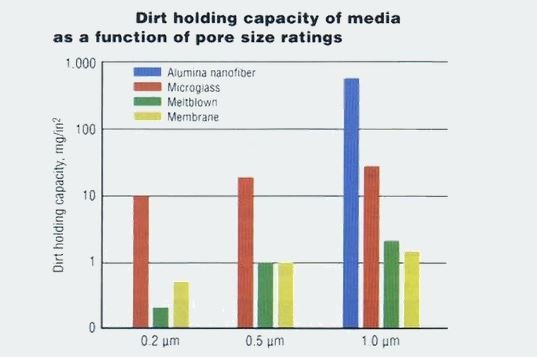
Dirt holding capacity of filter media
The dirt-holding capacity of a filter is the amount of dirt the filter element can trap before reaching its full-service life.
The rate of fluid flow determines the dirt holding capacity of a filter.
It is fundamental in designing the size of a filter for industrial applications.
Understanding the effects of fluid flow rates on the dirt holding capacity of a filter is essential for determining the service life of the filter.
It can also help in determining the number of filters that the system will require to achieve the filter change-out target.
When calculating the dirt holding capacity, first, you need to determine the rate and quantity of dirt that is getting into the filter.
Determine the amount of total suspended solids in ppm or mg/L and the flow rate in liters or gallons per minute.
Using the above information, mathematically calculate the dirt holding capacity in these steps;
- Calculate the contaminants inlet rate
- Multiply the amount of total suspended solids to the volume of flow rate
- Present your results in grams per minute
- Convert the dirt holding capacity in grams per minute to grams or kilograms per day.
How can you Determine the Service Life of a High Flow Filter?
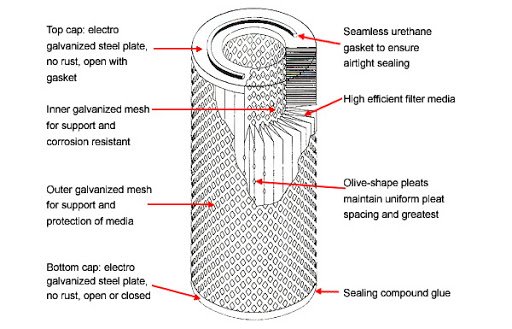
Inside cartridge filter
The service life of a filter is the period in which the high flow filter will remove contaminants before reaching full dirt holding capacity.
You must predetermine the dirt holding capacity of the filter at a given flow rate before you can determine the service life of a filter.
In some cases, the information is supplied together with the high flow filter cartridge.
Using this information, consult the test protocol graphs provided along with the filter to determine how long it will last.
However, the performance and period of service will vary from one application to the other depending on the fluid type and nature of contaminants.
How do you Choose High Flow Cartridge Filter Housing?
The high flow filter housing is an integral part of the filtration system, and poor selection will significantly affect the efficiency of your filtration.
When selecting the housing, take the following considerations into account.
· Design of the Filter
Different designs of housing have different abilities to house a different number of filter cartridges.
Similarly, specific designs are also suited for particular applications that have special filtration requirements.
For example, some filter housing designs have devices that allow for automatic cleaning.
· Operating Pressure and Temperature
Ensure that you select a housing design that can withstand the maximum filtration pressure of your system.
The design pressure is influenced by the operating temperature hence ensure that you select housing with an appropriate combination.
Selecting a filter with a higher or lower working temperature will also reduce the efficiency of the filtration process.
· Construction Material
Even though you can select several materials for the construction of a high flow filter, the most commonly used are stainless steel and carbon steel.
You can choose different classes of these materials.
The choice of material will depend on the application requirement and operating environment of the filter.
· Cover Type
You can select between swing bolt-hinged, clamp, or davit arm cover covers for your filters.
· Design Orientation
The housing configuration can either be vertical or horizontal.
Choose the most appropriate for your process.
· Flow Rate
Different models of high flow filters have different maximum flow rates.
Ensure that the housing model and design you choose are compatible with the system flow rates.
Similarly, the flow pattern also varies from one model to the other.
Designs that filter from outside to inside are simple to use and operate.
Alternatively, you can also select a design that filters from inside to outside.
However, this design requires a cartridge sealing using a large support plate.
· Housing Size/Dimension
The size of the housing depends on the flow rate and type of the filter element.
If the contamination level is high, then a bigger house is required to host multiple cartridges or a single cartridge with large dirt holding capacity.
· Inlet/Outlet Connection Sizes and Position
You should ensure that the size of the inlet and outlet ports of the filter corresponds to the piping system of your application.
The positioning of ports will also facilitate a smooth connection to the system application.
What are the High Flow Filter Quality Standards?
High flow filters should meet ISO 9001 standards, which provide requirements for meeting quality management systems.
Isolated countries and trade unions also specify regulatory standards that must be adhered to when using high flow filters in specific industries.
For example, the Food Contact Directive (EC) 1935/2004 standards require that you should use stainless steel to make the housing.
The O-ring accompanying the housing should also adhere to requirements of FDA 21CFR part 11.
The following standards also influence the design of filter housing; PDE Category IV, AD Merkblatter, EN13445, U Stamp, and CODAP & ASME Div VIII.
When manufacturing filter housing for systems filtering pressurized fluids for the European market, then you have to comply with PED 2014/68/EU 3.
Generally, there are many quality regulatory standards specific to different industries, markets, and countries.
Ensure that you confirm with the relevant authorities before purchasing the high flow filters.
What should you consider when buying high flow filters?
Optimal performance of high flow filters will be influenced by numerous factors that you must carefully consider before placing your order.
They include:
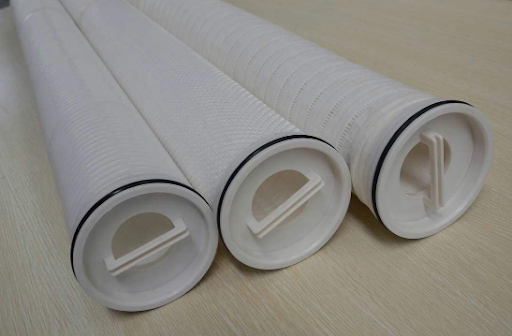
High flow filter element
· Material and Contaminants Characteristic
Understanding the size and types of particle contaminants will enable you to choose a high flow filter with the correct micron rating.
The right micron rating will ensure that you achieve the desired level of filtration.
In industries like food, beverage, and pharmaceuticals, the filter must be able to remove all undesired contaminants to avoid unnecessary losses.
· Process Fluid Properties
You should familiarize yourself with the chemical properties of the process liquid or gas you intend to filter.
Different fluids contain or produce various chemicals that may affect the integrity and performance of your filters.
The choice of construction material will highly depend on the fluid properties.
Corrosive and saline fluid require inert materials that r.
· Flow Rates
Different filter models have different optimum flow rates beyond which the filter will cause a lag in the process of fluid flow and extreme pressure drop.
Ensure that you match the filtration needs of your application to the specifications of a filter before purchase.
You should also consider the minimum flow rate of the filter you clean the filter using backwash.
· Operating Pressure
Select a filter whose operating pressure to coincide with that of your filtration process.
Each type and model of filter has a different rating of operating pressure, and hence accurate selection for maximum pressure is mandatory
· Operating Temperature
You should know the working temperature of the process fluid before choosing a filter media.
Different media have a maximum temperature beyond which the elements will collapse.
For example, the most used medium made from polypropylene will not withstand temperatures beyond 100°C in most cases.
· Environmental and Operator Health
Properties of contaminants and process fluid influence this condition.
Whereas some filtration systems have acceptable levels of exposure, both to the operator and environment, some processes do not.
In the case of hazardous compounds, ensure that the media you select will meet the standards of exposure provided for under safety regulation.
· Operation Cost
The operation cost of high flow filters will vary from one design or model of a filter to the other.
You should consider the cost of initial purchase, labor, and downtime for the replacement of elements and waste disposal costs.
What Fluid Compatibility Conditions for High Flow Filters?
Chemical compatibility of a filter is the harmonious correlation between the materials used to construct the housing and the filter elements.
You must ensure that your process fluid is chemically compatible with filter construction materials to minimize risks of failure during filtration.
Also, you should also consider whether the filter is also compatible with the contaminants.
The solvents can chemically attack the screen resulting in filter degradation and release of pollutants into the system.
Some contaminant doesn’t degrade the elements but alters the pore sizes and function of the filter by getting absorbed into the media fibers.
Chemical compatibility of high flow filters will be affected by temperature, pressure, chemical concentration, and the length of exposure time.
These factors will affect the filtration process, either individually or in combination.
You should test the effects of any chemical additive, acid, base, and PH on the filter before embarking on full-scale filtration.
Some high flow filters made using polypropylene has shown compatibility to the following chemicals at different concentrations and temperature range.
- Acetic acid
- Hydrogen peroxide
- Alkanomines
- Methyl ethyl ketone
- Ammonium hydroxide
- Bleach
- Mineral oil
- Sulfuric acid
- Ethylene glycol
- Nitric acid
- Potassium hydroxide
- Urea
- Sodium hydroxide and
- Sodium carbonate
Can you clean a high flow cartridge filter?
Yes, high flow filters are cleanable.
You can either opt for a manual cleaning or automatic cleanable filter.
· Manual Cleaning
Ensure that you shut down the system to allow the elements to cool before opening the filters.
Stop fluid flow using the shut off valve.
Remove the filter elements and scrub them using a brush or other compatible liquid to removed dirt.
Air-dry the elements before placing it back into the filter.
Alternatively, you can use ultrasonic cleaning or backwashing with pressurized water/compressed gas.
· Automatic Cleaning
Automatic cleaning filters initiate self-cleaning when the pressure drop reaches a certain predetermined level.
Self-cleaning filters use different techniques to dislodge dirt off the elements.
In some screens, the dirty cartridges rotate and rub itself against the scrapper, which removes the particles.
The dislodge dirt is collected at the bottom of the filter in a collector.
Self-cleaning filters can clean continuously without having to stop the filtration process and, therefore, suitable for operations that cannot stop.
What is the Absolute Rating for High Flow Filter Cartridge?
Absolute micron rating, also denoted as AMR, is a rating style that you obtain after passing a fluid treated with a known amount of glass beads.
You will then capture and measure the number of glass beads that go through the filter.
It is a cut-off point that reflects the size of the largest glass bead that can go through the filter.
What is a Micron Rating in a High Flow Filter Cartridge?
The type of contaminants and process fluid that flow through the filter will determine the micron rating of a high flow filter.
The rating indicates the size of particles the filter is capable of removing.
A micron rated filter should contain additional information describing the kind of test used and procedures followed in conducting the analysis.
You can rate high-flow filters from 1 micron to 70 microns.
How can you Determine the Particle Removal Efficiency of High Flow Filter Cartridge?
You can conduct a multi-test method and generate a ‘Beta ratio’ to describe the filtration efficiency of a filter.
ISO 16889:2008 specify the requirements and procedures for conducting the Multi-pass test analysis.
You can follow the steps below to perform a Multi-pass test.
- Weigh and add a known volume of dust and mix it with a predetermined amount of fluid in the reservoir
- Slowly pass the fluid through the filter at a constant speed.
- Determine the number of particles present in the fluid on both sides of the filter using a particle counter.
- Divide the number of particles upstream by the number downstream to obtain the Beta ratio
- To determine the efficiency of the filter, subtract one from the Beta ratio then divide the result with the original beta ratio.
- Multiply the figure you get by 100 to get the percentage efficiency.
As you can see, to get the best high flow filters, it is important to consider everything mentioned in this guide.
It will help you analyze all the vital aspects of high filter filtration systems.
For custom orders or questions, contact FilSon Filters team for more clarifications.
